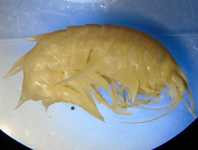Abstract
A single ovigerous female specimen of a new species of Epimeria Costa in Hope, 1851 was collected from deep sea, off southwestern Mexico, in the eastern Pacific. Epimeria karamani sp. nov., is most similar to females of E. cora J.L. Barnard, 1971, E. pacifica Gurjanova, 1995 and Epimeria morronei Winfield, Ortiz & Hendrickx, 2013. However, it differs from these species by: eyes long and slightly kidney-shaped; pleonite 3 strongly carinate, with dorsal tooth produced and acute; urosomite 1 with a wide mid-dorsal notch and a strong, upright blunt tooth; coxa 3 anterior margin slightly truncate and with two processes marginally; coxa 4 ventral margin linear, with facial granules and simple setae; gnathopods palm with distal bifid setae; telson straight medially, distal margin crenulate and with minute setae. The new species described herein increases the number of Epimeria species from the Pacific Ocean to 14, and from the eastern Pacific to three.
References
Barnard, J.L. (1961) Gammaridean Amphipoda from depths of 400 to 6000 meters. Galathea Report, 5, 23–128.
Barnard, J.L. (1971) Gammaridean Amphipoda from a deep-sea transect off Oregon. Smithsonian Contributions to Zoology, 61, 1–86.
https://doi.org/10.5479/si.00810282.61
Birstein, J.A. & Vinogradov, M.E. (1958) [Pelagic gammarids (Amphipoda, Gammaridea) from the northwestern part of the Pacific Ocean]. Akademiya Nauk SSSR, Trudy Instituta Okeanologii, 27, 219–257.
Boeck, A. (1871) Crustacea Amphipoda borealia et arctica. Forhandlinger i Videnskabs-Selskabet i Christiana, 1870, 83–280.
https://doi.org/10.5962/bhl.title.2056
Childress, J.J. & Seibel, B.A. (1998) Life at stable low oxygen levels: adaptations of animals to oceanic oxygen minimum layers. Journal of Experimental Biology, 201 (8), 1223‒1232.
Coleman, C.O. (2007) Synopsis of the Amphipoda of the Southern Ocean; Volume 2: Acanthonotozomellidae, Amathillopsidae, Dikwidae, Epimeriidae, Iphimediidae, Ochlesidae and Vicmusiidae. Bulletin de l’institut Royal des Sciences Naturelles de Belgique, Biologie, 77 (Supplement 2), 1‒134.
Coleman, C.O. & Lowry, J. (2014) Epimeria rafaeli sp. nov. (Crustacea, Amphipoda, Epimeriidae) from Western Australia. Zootaxa, 3873 (3), 218–232.
https://doi.org/10.11646/zootaxa.3873.3.2
Costa, A. (1851) Catalogo dei crostacei italiani e di moltri altri del Mediterraneo per Fr. Gugl. Hope. In. F. Azzolino, Naples, 48 pp.
d’Udekem d’Acoz, C. & Verheye, M.L. (2017) Epimeria of the Southern Ocean with notes on their relatives (Crustacea, Amphipoda, Eusiroidea). European Journal of Taxonomy, 359, 1–553.
https://doi.org/10.5852/ejt.2017.359
Gage, J.D. & Tyler, P.A. (1992) Deep-sea biology: a natural history of organisms at the deep-sea floor. Cambridge University Press, Cambridge, 504 pp.
https://doi.org/10.1017/CBO9781139163637
Gurjanova, E.F. (1955) Novye vidy bokoplavov (Amphipoda, Gammaridea) iz severnoi chasti Tixogo Okeana. Zoologicheskogo Instituta Akademii Nauk SSSR, Trudy 18, 166–218.
Helly, J.J. & Levin, L.A. (2004) Global distribution of naturally occurring marine hypoxia on continental margins. Deep Sea Research Part I: Oceanographic Research Papers, 51 (9), 1159‒1168.
https://doi.org/10.1016/j.dsr.2004.03.009
Hendrickx, M.E. & Serrano, D. (2010) Impacto de la zona de mínimo de oxígeno sobre los corredores pesqueros en el Pacífico mexicano. Interciencia, 35 (1), 12‒18.
Hendrickx, M.E. & Serrano, D. (2014) Effects of the oxygen minimum zone on squat lobsters distribution in the Gulf of California, Mexico. Central European Journal of Biology, 9 (1), 92‒103.
https://doi.org/10.2478/s11535-013-0165-6
Hendrickx, M.E., Winfield, I. & Ortiz, M. (2014) New records of the deep-water Epimeria morronei Winfield, Ortiz & Hendrickx, 2012 (Amphipoda: Gammaridea: Epimeriidae) in the East Pacific. Crustaceana, 87 (14), 1699‒1703.
https://doi.org/10.1163/15685403-00003378
Hurley, D.E. (1957) Some Amphipoda, Isopoda and Tanaidacea from Cook Strait. Zoology Publications from Victoria University College, 21, 1–20.
Johansson, B. (1997) Behavioural response to gradually declining oxygen concentration by Baltic Sea macrobenthic crustaceans. Marine Biology, 129 (1), 71‒78.
https://doi.org/10.1007/s002270050147
Latreille, P. (1816) Les Crustacés, les Arachnides et les Insectes. Vol. 3. Le Regne Animal, distribut d’après son Organisation, pour servir de Base l’Histoire naturelle des Animaux et de d’Introduction l’Anatomie Comparée. Chez Déterville, Paris, 653 pp.
Lörz, A.N. (2008) Epimeriidae (Crustacea, Amphipoda) from New Zealand with a description of a new species. Zootaxa, 1847 (1), 49–61.
https://doi.org/10.11646/zootaxa.1847.1.4
Lörz, A.N. (2011) Pacific Epimeriidae (Amphipoda: Crustacea): Epimeria. Journal of the Marine Biological Association of the United Kingdom, 91, 471–477.
https://doi.org/10.1017/S0025315410001086
Lörz, A.N. & Brandt, A. (2004) Phylogeny of Antarctic Epimeria (Epimeriidae: Amphipoda). Journal of the Marine Biological Association of the United Kingdom, 84, 179–190.
https://doi.org/10.1017/S002531540400904Xh
Lörz, A.N. & Coleman, C.O. (2014) Amazing new Amphipoda (Crustacea, Epimeriidae) from New Zealand’s deep-sea. Zootaxa, 3838 (4), 424–434.
https://doi.org/10.11646/zootaxa.3838.4.2
Lörz, A.N., Smith, P., Linse, K. & Steinke, D. (2012) High genetic diversity within Epimeria georgiana (Amphipoda) from the southern Scotia Arc. Marine Biodiversity, 42 (2), 137‒159.
https://doi.org/10.1007/s12526-011-0098-8
McCain, J.C. (1971) A new deep-sea species of Epimeria (Amphipoda, Paramphithoidae) from Oregon. Crustaceana, 20 (2), 159–166.
https://doi.org/10.1163/156854069X00187
Nagata, K. (1963) Two new gammaridean amphipods (Crustacea) collected by the second cruise of the Japanese Expedition of Deep-Sea (JEDS-2). Publications of the Seto Marine Biological Laboratory, 11, 1–5.
https://doi.org/10.5134/175328
Papiol, V., Hendrickx, M.E. & Serrano, D. (2016) Effects of latitudinal changes in the oxygen minimum zone of the northeast Pacific on the distribution of bathyal benthic decapod crustaceans. Deep Sea Research Part II: Topical Studies in Oceanography, 137, 113‒130.
https://doi.org/10.3897/BDJ.4.e8661
Serrano, D. 2012. La zona de mínimo oxígeno en el Pacífico mexicano. In: Zamorano, P., Hendrickx, M:E. & Caso, M. (Eds.), Biodiversidad y comunidades del talud continental del Pacífico mexicano. Secretaría del Medio Ambiente y recursos Naturales (SEMARNAT), Instituto Nacional de Ecología (INE), Mexico City, pp. 105‒119.
Shimomura, M. & Tomikawa, K. (2016) Epimeria abyssalis sp. n. from the Kuril-Kamchatka Trench (Crustacea, Amphipoda, Epimeriidae). ZooKeys, 638, 125–142.
https://doi.org/10.3897/zookeys.638.10329
Verheye, M.L., Lörz, A.N. & d’Udekem d’Acoz, C. (2018) Epimeria cleo sp. nov., a new crested amphipod from the Ross Sea, Antarctica, with notes on its phylogenetic affinities (Crustacea, Amphipoda, Eusiroidea, Epimeriidae). Zootaxa, 4369 (2), 186–196.
https://doi.org/10.11646/zootaxa.4369.2.2
Winfield, I., Ortiz, M. & Hendrickx, M.E. (2013) A new deepwater species of Epimeria (Amphipoda: Gammaridea: Epimeriidae) from the continental slope of western Mexico. Journal of the Marine Biological Association of the United Kingdom, 93 (4), 991–997.
https://doi.org/10.1017/S0025315412001257


